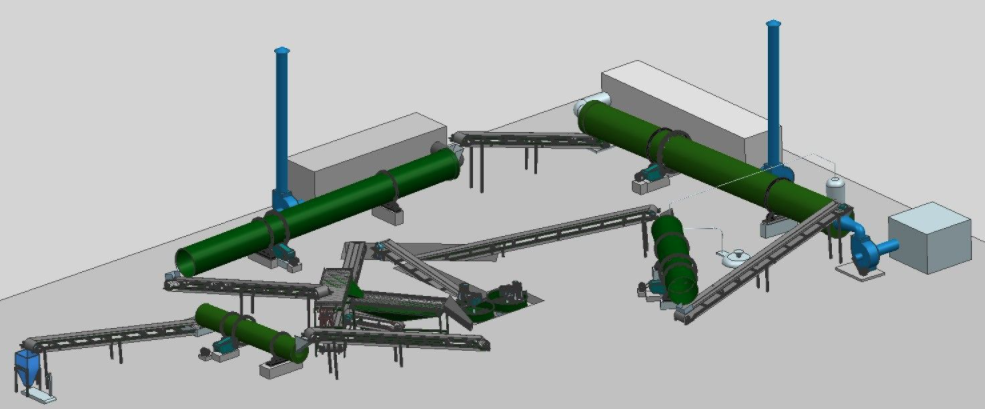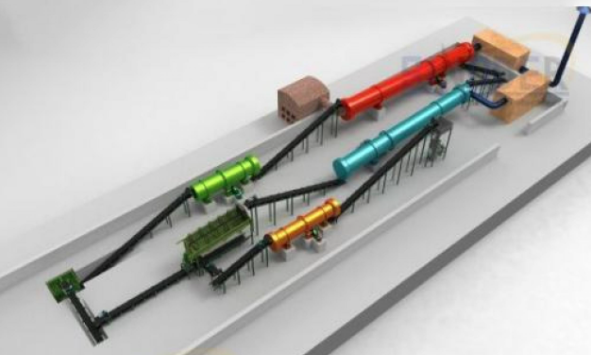
Waste treatment - Complete Organic fertilizer production line
- Description details
-
Working Process of Bio organic Fertilizer Production Line
Organic fertilizer production line is a complete set of equipment from raw materials collection to the organic fertilizer packing.
1) Organic Materials Fermentation Process: Which plays the preliminary but indispensable role in the whole production line. Two main types of compost turner are widely used to turn and mix the compost and accelerate the fermentation speed, Self-propelled compost turner and hydraulic compost turner.
2) Crushing Process: The compost lump materials should be grinded before the granulating process. But we can leave out crushing process when the compost material is fine enough. Vertical chain crusher and double-shaft horizontal crusher, two types of crushing machine can be used to crush lump compost fertilizer raw materials.
3) Mixing Process: two types of mixing machine are applied to mix raw materials in the fertilizer production line: horizontal mixer and vertical mixer.
4) Granulator Process: Granulating process is the core part in this production line, so we choose the suitable model of fertilizer granulator according to customers detailed requirements. Disc granulator machine can be chosen to granulate the materials evenly.
5) Drying Process: When granulating, the moisture of fertilizer raw materials should be less than 25%, so we should dry the raw materials if the moisture is more than 25%.Rotary drum drying machine is mainly used for drying the fertilizer with a certain degree of humidity and particle size.
6) Rotary Drum Cooling Machine: Which is used for cooling fertilizer to make fertilizer particles stronger.
7) Rotary Drum Screening Machine: which is used to separate the granules from the large particles which need to be returned for the second crushing and granulating. Rotary drum coating machine is used to coat the fertilizer and prevent the fertilizer from sticking together.
8) The last process is packaging process: Fertilizer packaging machine can package bags quantitatively and automatically. We also need some auxiliary equipment for connection such as belt conveyor, bucket elevator, etc. 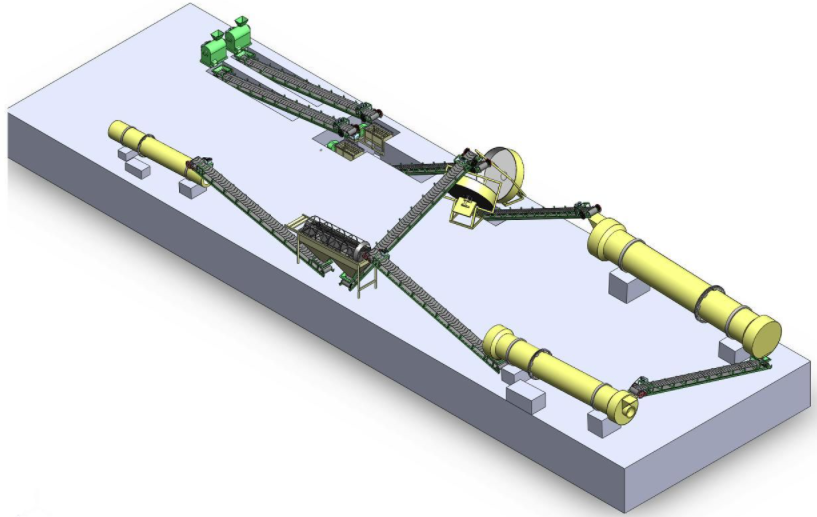
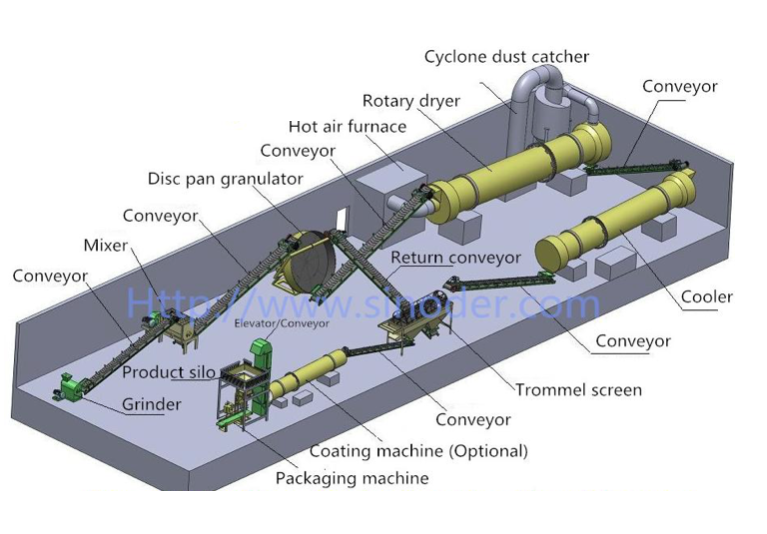
- Specifications
-
Bio-organic Fertilizer Production Line
Organic fertilizer production line with the capacity of 3000-200,000 tons/year.
Introduction of Bio-organic Fertilizer Production Line
The bio-organic fertilizer production line is commonly used to process different fermented organic substance into bio-organic fertilizer. It adopts one-step molding technology. Animal manure and agricultural waste are recycled as the main raw materials, thus manure or dung waste is not only creating economic benefits for the enterprise, but also making a great contribution to environmental projects for mankind.
The raw material of organic fertilizer project:
1. Agricultural waste: straw, rice bran, etc.
2. Animal waste: chicken manure, pig, cattle and sheep manure, etc.
3. Industrial waste: vinasse, sugar residue, etc.
4. Household waste: kitchen waste, vegetable market and slaughterhouse waste, etc.
5. Municipal sludge: river silt, sewage sludge, etc. 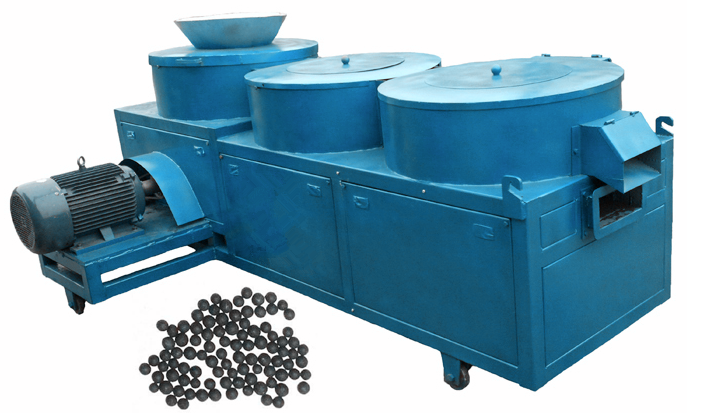
Main parts of fertilizer production line:
1. Turner Machine
2. Half-wet Material Crusher
3. Mixer
4. Disc Granulator
5. Drying Machine
6. Cooling Machine
7. Drum Screening Machine
8. Rotary Coating Machine
9. Belt Conveyor
10. Automatic Packaging Machine
Note: We can manufacturing fertilizer machine according to customers requirements.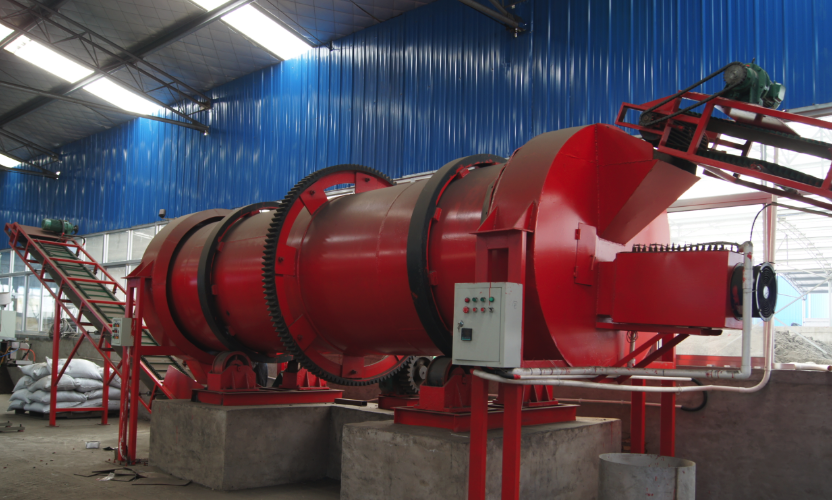
Features of Bio-organic Fertilizer Production Line
1. The line takes animal manure and agricultural waste as its main material, not only turns the waste into treasure, but also protects the environment.
2. The whole fertilizer production process is centralized controlled, so this series of fertilizer machines are highly automatic and easy to operate.
3. Both batching system and packing system are controlled by the computer, thus ensuring the precision of material batching and fertilizer packing.
4. High-quality, stable performance, compact process layout, advanced technology, and convenient maintenance.Working Process of Bio-organic Fertilizer Production Line
Organic fertilizer production line is a complete set of equipment from raw materials collection to the organic fertilizer packing.
1) Organic Materials Fermentation Process: Which plays the preliminary but indispensable role in the whole production line. Two main types of compost turner are widely used to turn and mix the compost and accelerate the fermentation speed, Self-propelled compost turner and hydraulic compost turner.
2) Crushing Process: The compost lump materials should be grinded before the granulating process. But we can leave out crushing process when the compost material is fine enough. Vertical chain crusher and double-shaft horizontal crusher, two types of crushing machine can be used to crush lump compost fertilizer raw materials.
3) Mixing Process: two types of mixing machine are applied to mix raw materials in the fertilizer production line: horizontal mixer and vertical mixer.
4) Granulator Process: Granulating process is the core part in this production line, so we choose the suitable model of fertilizer granulator according to customers detailed requirements. Disc granulator machine can be chosen to granulate the materials evenly.
5) Drying Process: When granulating, the moisture of fertilizer raw materials should be less than 25%, so we should dry the raw materials if the moisture is more than 25%.Rotary drum drying machine is mainly used for drying the fertilizer with a certain degree of humidity and particle size.
6) Rotary Drum Cooling Machine: Which is used for cooling fertilizer to make fertilizer particles stronger.
7) Rotary Drum Screening Machine: which is used to separate the granules from the large particles which need to be returned for the second crushing and granulating. Rotary drum coating machine is used to coat the fertilizer and prevent the fertilizer from sticking together.
8) The last process is packaging process: Fertilizer packaging machine can package bags quantitatively and automatically. We also need some auxiliary equipment for connection such as belt conveyor, bucket elevator, etc.